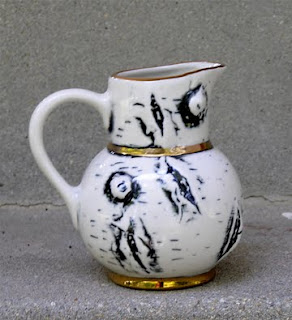



At the risk of seeming to “beat a dead horse,” I return to the subject of Beam bottles, specifically decanters in its self-vaunted “Executive” series -- a subject first raised in my posting on September 3 of this year.
Recently on eBay four decanters in the Executive Series, shown here, were offered as a group with bidding beginning at $9.99. From left to right, they were “Charisma” issued by the Jim Beam distillery in 1970, “Flora de Oro” from 1976, “Reflections” from 1975, and “Regency” from 1972. All were attested to be in excellent condition.
Researching the values placed on these decanters in recent bottle price guides, Charisma by itself was worth $15, although by 2005 the Antique Trader guide had reduced it to $4-7. Flora de Oro warranted a $12 value from both. Koval set Reflections at $13 and Regency at $12; Antique Trader valued them at $8-10 and $7-9, respectively.
Using Koval’s as a guide, the total value of the four was $52; for Antique Trader the total was $38. Yet the opening asking price on eBay was $9.99 or approximately $2.50 each. Even at that that give-away price, there were no bidders. Nobody in eBay’s national audience was interested even at a bargain basement price.
Recall that this series was touted by early Beam Bottle guides in glowing terms. A 1967 example of the hyperbole about the Beam Executives: “Decanters in this series are highly sought after by collectors today and will surely be tomorrow’s treasured antiques! Most everybody, even non-collectors it seems, cherishes these bottles. Consequently the empty bottles are very seldom seen offered for re-sale.”
Wrong! They come up for sale all the time. Just after the Beam quartet failed to find a buyer, the 1965 “Marbled Fantasy”, shown here, was offered in original box at $25. Again no bidder. This item was valued at $27 in 1967 and $42 in 2005. Same result as earlier: no bidders.
I have only one Beam item, purchased more than 20 years ago. It is a small stoneware pitcher issued by the Milwaukee Jim Beam Club that imitates the bark of a white birch tree. I have kept it not because it will be “tomorrow’s treasured antique,” and someday hope to make a bundle on it, but because it is from a town to which I have emotional ties and because it has a highly unusual motif.
There is one final indignity to relate to Beam bottle collectors. The Executive Series quartet shown here subsequently was relisted on eBay. This time their owner asked $24 for the lot on a “buy it now” or “best offer" basis. Again, there were no takers. Once touted as tomorrow’s treasures, Beam decanters instead are today’s duds.






